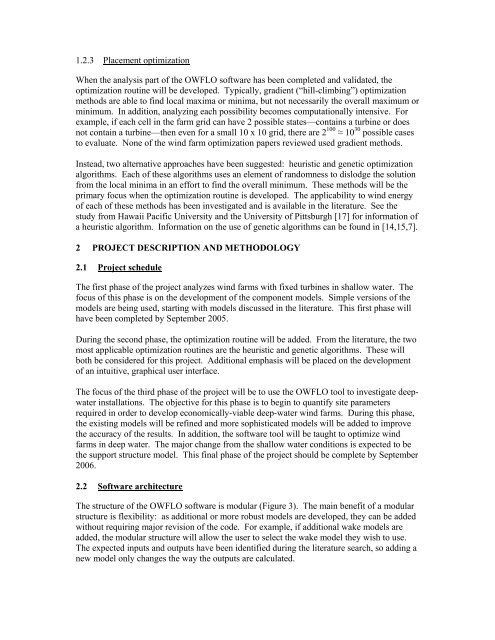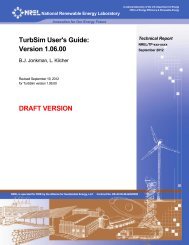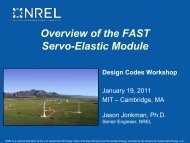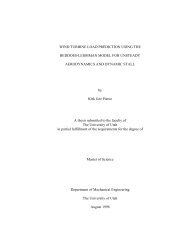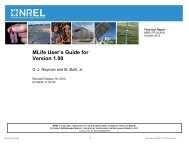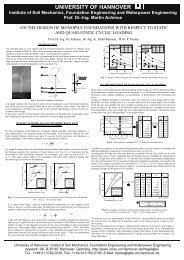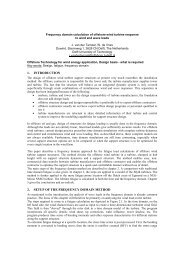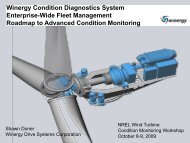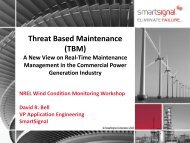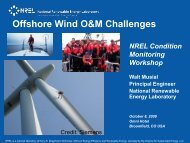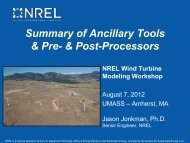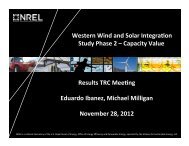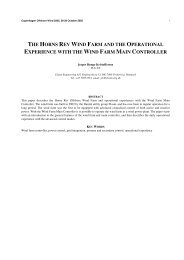OFFSHORE WIND FARM LAYOUT OPTIMIZATION (OWFLO ...
OFFSHORE WIND FARM LAYOUT OPTIMIZATION (OWFLO ...
OFFSHORE WIND FARM LAYOUT OPTIMIZATION (OWFLO ...
You also want an ePaper? Increase the reach of your titles
YUMPU automatically turns print PDFs into web optimized ePapers that Google loves.
1.2.3 Placement optimizationWhen the analysis part of the <strong>OWFLO</strong> software has been completed and validated, theoptimization routine will be developed. Typically, gradient (“hill-climbing”) optimizationmethods are able to find local maxima or minima, but not necessarily the overall maximum orminimum. In addition, analyzing each possibility becomes computationally intensive. Forexample, if each cell in the farm grid can have 2 possible states—contains a turbine or doesnot contain a turbine—then even for a small 10 x 10 grid, there are 2 100 ≈ 10 30 possible casesto evaluate. None of the wind farm optimization papers reviewed used gradient methods.Instead, two alternative approaches have been suggested: heuristic and genetic optimizationalgorithms. Each of these algorithms uses an element of randomness to dislodge the solutionfrom the local minima in an effort to find the overall minimum. These methods will be theprimary focus when the optimization routine is developed. The applicability to wind energyof each of these methods has been investigated and is available in the literature. See thestudy from Hawaii Pacific University and the University of Pittsburgh [17] for information ofa heuristic algorithm. Information on the use of genetic algorithms can be found in [14,15,7].2 PROJECT DESCRIPTION AND METHODOLOGY2.1 Project scheduleThe first phase of the project analyzes wind farms with fixed turbines in shallow water. Thefocus of this phase is on the development of the component models. Simple versions of themodels are being used, starting with models discussed in the literature. This first phase willhave been completed by September 2005.During the second phase, the optimization routine will be added. From the literature, the twomost applicable optimization routines are the heuristic and genetic algorithms. These willboth be considered for this project. Additional emphasis will be placed on the developmentof an intuitive, graphical user interface.The focus of the third phase of the project will be to use the <strong>OWFLO</strong> tool to investigate deepwaterinstallations. The objective for this phase is to begin to quantify site parametersrequired in order to develop economically-viable deep-water wind farms. During this phase,the existing models will be refined and more sophisticated models will be added to improvethe accuracy of the results. In addition, the software tool will be taught to optimize windfarms in deep water. The major change from the shallow water conditions is expected to bethe support structure model. This final phase of the project should be complete by September2006.2.2 Software architectureThe structure of the <strong>OWFLO</strong> software is modular (Figure 3). The main benefit of a modularstructure is flexibility: as additional or more robust models are developed, they can be addedwithout requiring major revision of the code. For example, if additional wake models areadded, the modular structure will allow the user to select the wake model they wish to use.The expected inputs and outputs have been identified during the literature search, so adding anew model only changes the way the outputs are calculated.


